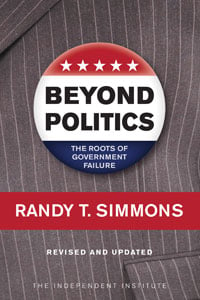Beyond Politics: The Roots of Government Failure by Randy Simmons. Oakland, CA: Independent Institute, 2011 (revised and updated edition). 368 pp. $22.95 (paperback).

If you want to learn the theories and history of economists who champion government controls of the economy—and of economists who criticize such intervention—Randy T. Simmons’s Beyond Politics: The Roots of Government Failure is a fantastic resource.
As the title of the work suggests, Simmons believes that, most often, government creates far more problems in the economy than it solves. The revised and updated 2011 edition, based on the 1994 book by Simmons and William C. Mitchell, covers recent economic research and recent events, such as the mortgage crisis, in making its case.
Although Simmons’s book contains some complex graphs and discussions of technical economics, it is accessible to ambitious laypersons, especially those with some background in economics. The language is occasionally dense and difficult to read, but mostly the contents are organized sensibly and explained clearly. I particularly appreciate the bibliographical notes with which Simmons ends each chapter; these are useful guideposts for further reading on a host of topics.
Simmons divides his book into four main parts (plus a concluding part in which he discusses strategies for “creating a climate for liberty”).
In Part I, Simmons lays out the standard case for government intervention, focusing on the various types of alleged “market failures” said to justify government action. Simmons summarizes:
“Market failure” is the modern justification for government action. And that justification has been used by consumers, activists, politicians, special interests, and bureaucrats to produce broad-ranging programs, rules, and agencies to control and influence economic choices. Political control over private economic action became a fact of life during the last century. Rent control, pollution regulation, safety rules, import restrictions, fuel economy standards, and thousands of other controls have been enacted to overcome perceived imperfections in markets. (p. 5)
Simmons discusses a wide range of stipulated causes of “market failure,” including “externalities” (“costs” imposed on others without their consent), “public goods,” and “imperfect” competition. Simmons explains that, to address such stipulated problems, the political scientists and economists who favor expansive government control of the economy tend to regard the state as an ideal, beneficent mechanism by which informed “scientific managers” can correct “market failures.”
In Part II, Simmons begins by explaining the main tenets of the “public choice” school of economics, the school popularized by the late Nobel laureate James Buchanan of George Mason University. Simmons writes:
Public choice scholars have shown that governments do not easily fix market failures; they usually make things worse. The fundamental reason is that the information and incentives that allow markets to coordinate human activities and wants are not available to government. Thus, voters, politicians, bureaucrats, and activists who believe themselves to be promoting the public interest are led by an invisible hand to promote interests other than the public interest. (p. 49)
Government agents, Simmons argues, far from being unbiased, public-spirited servants, tend to “achieve outcomes consistent with their self-interest” (p. 51). (Simmons’s use of the terms “public interest” and “self-interest” creates serious problems for his analysis, a problem to which we will return.) Simmons argues that, for a variety of reasons ranging from the political manipulation of votes to the inability of bureaucrats to calculate the value of “public goods,” government controls of the economy often do more harm than good.
In Part III, Simmons discusses the institutions of a free market—including private property rights and laws protecting such rights—that are so important to a prosperous economy. And, in the seven chapters of Part IV, Simmons applies the findings of his more-theoretical chapters to a host of specific issues, including antitrust law, laws intended to “protect” consumers, government-run schools, “environmental” controls, and inflation. Simmons calls these “case studies in the anatomy of government failure.”
A couple of examples from these chapters will indicate their flavor.
Regarding price supports for farmers, the government has intentionally implemented policies that reduce the production of food and drive up costs for consumers, Simmons explains. These controls have caused a range of “unintended consequences” as well. For example, many farmers responded to the government’s forced limits on acreage used for farming by “applying more fertilizer and labor to the reduced acreage,” thereby farming less efficiently than they otherwise would (p. 191).
Regarding regulations of coal-burning plants, the Clean Air Act Amendments of 1977 required some such plants to install scrubbers to remove sulfur dioxide. Simmons describes some of the resulting problems:
Forced scrubbing . . . only applies to new plants; plants existing prior to the legislation were allowed to continue to emit four or five pounds of [sulfur dioxide] per MBTU [million British thermal units per hour]. Since adding scrubbers increases the cost of a new power plant by about 15 percent, old plants continue to be kept in production far longer than they would be otherwise. Incidentally, this “old plant effect” outweighs the extra benefits on air quality of forcing all new plants to scrub. (p. 264)
Interestingly, the chapter on “environmental” regulations offers an excellent review of the work of the influential economists A. C. Pigou, who advocated the now-standard tax-and-regulate approach, and Ronald Coase, who emphasized private agreements among property-rights holders to resolve various conflicts.
Although I recommend Beyond Politics as an insightful guide to various aspects of economics, particularly the “public choice” school, the book suffers from two serious, related flaws: It leaves ambiguous the meaning of “public interest” and “self-interest,” and it often assumes the proper standard for government action is a collectivist one.
As indicated above, Simmons believes that political actors, including members of lobby groups, act in their “self-interest” (as opposed to the “public interest”) by seeking subsidies, government controls that hamper competitors, and the like. Simmons thereby equates “self-interest” with shortsighted dollar grabbing that totally ignores others’ rights and the fundamental requirements of long-term success and prosperity. Actual, rational self-interest consists (among other things) in producing wealth with the goal of long-term success, respecting individual rights, and advocating a government committed to protecting rights.
Now, what is the “public interest,” and how might political actors pursue it? Simmons leaves the answers to such central questions unanswered, or, at best, ambiguously answered. Simmons often implies that the “public interest” is whatever happens when people don’t pursue their narrow “self-interest”—even though, as the 20th century demonstrated, the most dangerous political actors are those who preach and practice self-sacrifice for the sake of the “public interest.”
Regarding the collectivist political standard often espoused or implied by Beyond Politics, consider that Simmons devotes a paltry one-and-a-half pages to the theoretical justification of individual rights. And this he titles “Natural Rights?”—with the question mark to indicate his skepticism or uncertainty regarding the existence of rights.
Simmons introduces this brief section by writing, “The discussion about property to this point has been rather utilitarian—clearly defined and enforced property rights bring narrow personal interests into harmony with the general welfare as measured by market transactions.” Contrasted to the collectivist, utilitarian framework assumed throughout most of the book, Simmons explains, “A moral, rather than utilitarian, understanding of property is the Lockean view that property rights are natural rights. . . . [and that] government’s purpose is to protect those rights” (pp. 139–40).
At least Simmons brings up the issue of individual rights, and by “rights” he means more than government-granted permissions. This is more than what most economists do, even those friendly to free markets. Unfortunately, Simmons leaves the matter as a barely explored aside. He does not attempt to justify individual rights or justify government actions on the basis of rights. Instead, he begins with and quickly returns to a collectivist, utilitarian framework, holding as the standard of government action a vague notion of the “public good,” the “public interest,” or the “general welfare.” This is hardly a failing unique to Simmons; most economists today explicitly claim to eschew moral philosophy while clinging—without justification—to the collectivist moral presumption of utilitarianism.
Simmons’s treatment of government-sponsored welfare illustrates the problems he runs into by shunting rights to the side. Simmons claims that “altruism”—another term he leaves poorly defined—seems to justify wealth transfers to the poor (p. 285). Unfortunately, he suggests, the “free-rider dilemma” (the reputed problem that many will not voluntarily contribute to charity) may require “coerced contributions” (p. 286). But, what of the barely aforementioned individual rights? Simmons pays them little mind here. He recognizes that government-sponsored welfare leads to myriad problems, including the “sacrifice of individual liberty” (p. 294). But, rather than advocate the individual’s right to dispose of his income as he sees fit, Simmons advocates “equality of opportunity” (whatever that means), achieved by a “reduced role for government” (reduced by how much, and by what standard, he doesn’t say) and “a freer private economy” (how free he doesn’t say) (p. 295). Because he fails to embrace the principle of individual rights, Simmons is reduced to piecemeal advocacy of partial freedom, partial controls.
Despite its serious theoretical problems—problems shared by most economic texts today—Beyond Politics offers a powerful critique of many types of government economic controls. Those who read it carefully will better understand the common rationale for government intervention in the economy—and the “public choice” criticisms of such intervention. Although Simmons does not offer anything like a complete case for capitalism that integrates morality and economics, he offers some important economic tools useful in building or fortifying such a case.


![[TEST] The Objective Standard](https://test.theobjectivestandard.com/wp-content/uploads/2017/10/logo.png)














